Search Result
Results for "
blue fluorescent
" in MedChemExpress (MCE) Product Catalog:
| Cat. No. |
Product Name |
Target |
Research Areas |
Chemical Structure |
-
- HY-D0068
-
|
7-Diethylaminocoumarin-3-carboxylic acid, SE
|
Fluorescent Dye
|
Others
|
|
DEAC, SE (7-Diethylaminocoumarin-3-carboxylic acid, SE) is an excellent blue fluorescent building block for labeling amine-containing biomolecules.
|
-
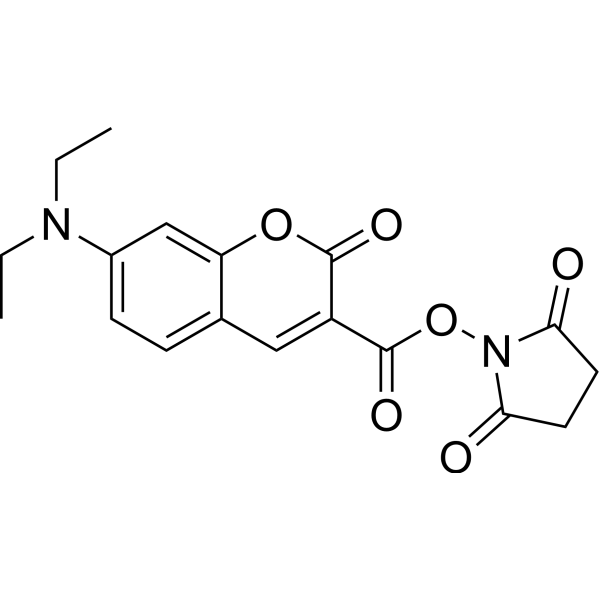
-
- HY-W011618
-
|
|
Fluorescent Dye
|
Others
|
|
N-(9-Acridinyl)maleimide is a maleimide type fluorescent thiol reagent. N-(9-Acridinyl)maleimide shows no substantial fluorescence but its coupling products with thiol compounds exhibit strong blue fluorescence. N-(9-Acridinyl)maleimide is used for fluorometrical analysis of cysteine and glutathione .
|
-
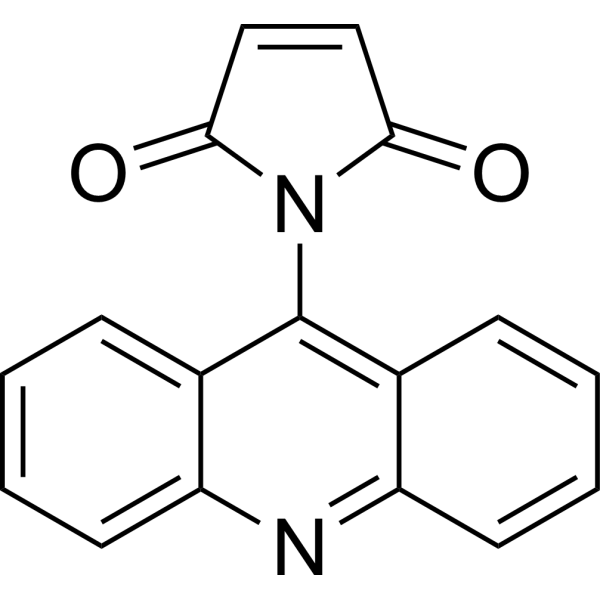
-
- HY-145385
-
|
|
Fluorescent Dye
|
Others
|
|
Coelenteramide is a oxidative product of Coelenterazine (HY-18743). Coelenteramide can form a complex with apoAequorin/Ca 2+, which is known as blue fluorescent protein (BFP) and shows continuous weak luminescence with Coelenterazine like a luciferase. Coelenteramide can be used as an imaging agent .
|
-

-
- HY-D0115
-
|
|
DNA Stain
|
Others
|
|
7-Hydroxycoumarin-3-carboxylic acid N-succinimidyl ester is the amine-reactive succinimidyl ester of 7-Hydroxycoumarin-3-carboxylic acid. 7-Hydroxycoumarin-3-carboxylic acid N-succinimidyl ester is a blue fluorescent dye for labeling proteins and nucleic acids .
|
-
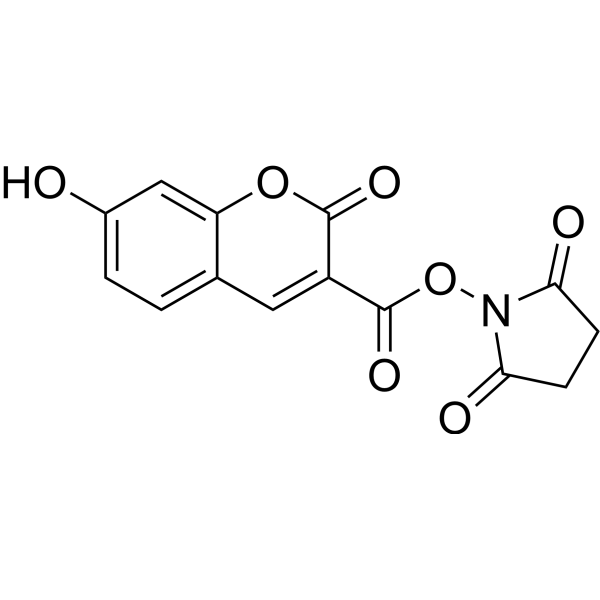
-
- HY-D1775
-
|
|
Fluorescent Dye
|
Others
|
|
Lysotracker blue DND-22 is a blue-fluorescent probe for staining acidic compartments in live cells.
|
-

-
- HY-D1445
-
|
|
Fluorescent Dye
|
Metabolic Disease
|
|
PDMPO, a lysosome pH indicator, is an excellent fluorescent acidotropic reagent for fluorescence imaging. PDMPO is a potent tool with which to study acidic organelles of live cells. PDMPO exhibits pH-dependent dual-excitation and dual-emission spectral peaks. PDMPO produces a blue fluorescence in weakly acidic organelles and shifts to yellow in more acidic lysosomes (Abs=329 nm; Em=440 nm) .
|
-
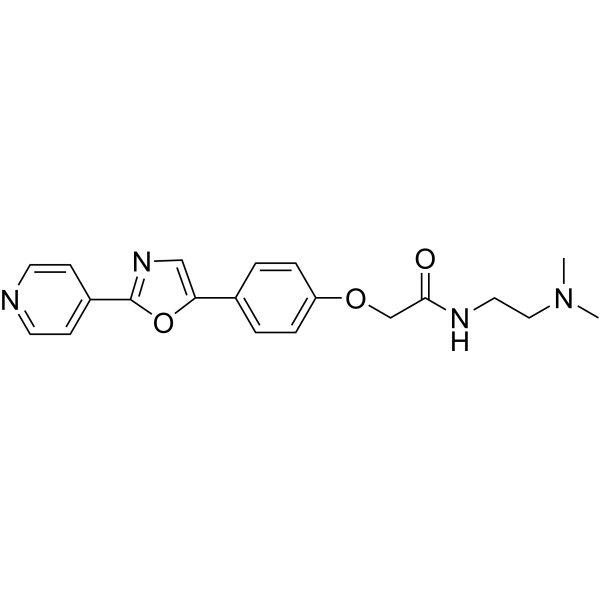
-
- HY-101887
-
|
|
Fluorescent Dye
|
Others
|
|
Calcein Blue, a membrane-impermeant fluorescent dye, is a coumarin derivative that contains an iminodiacetic acid structure. Calcein Blue is also a metallofluorochromic indicator .
|
-

-
- HY-D1462
-
|
|
Fluorescent Dye
|
Others
|
|
CellTracker Blue CMAC is a fluorescent dye , whose chloromethyl group can form a covalent bond with cell proteins. CellTracker Blue CMAC providing a stable attachment permitting long-term cell tracking .
|
-
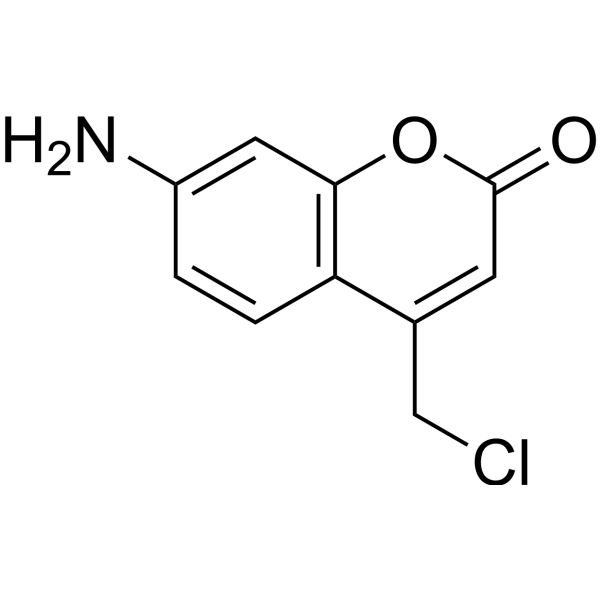
-
- HY-W110898
-
|
|
Fluorescent Dye
|
Others
|
|
Nile blue chloride is a highly fluorescent and photostable organic dye. Nile blue chloride and fluorescein isothiocyanate (FITC) can be used to construct a ratiometric pH sensitive probe for tracking the pH of the extracellular fluid between cancer cells in realtime. Nile Blue chloride has the potential for the research of nonlinear optics .
|
-

-
- HY-D0017
-
|
DNSCl
|
Fluorescent Dye
|
Others
|
|
Dansyl chloride is a reagent that produces stable blue or blue-green fluorescent sulfonamide adducts in the reaction of aliphatic and aromatic amines with primary amino groups, and is widely used for modified amino acids, protein sequencing and amino acid analysis .
|
-
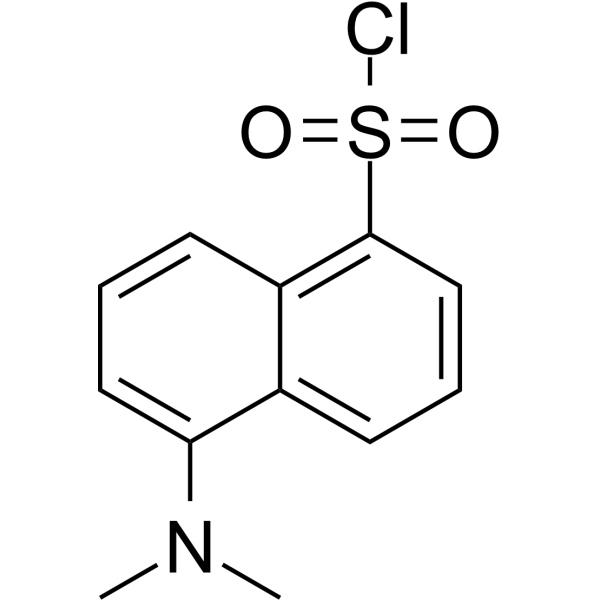
-
- HY-D1161
-
|
NCI 240899
|
Fluorescent Dye
|
Neurological Disease
|
|
True Blue (NCI 240899) is a fluorescent dye, as neuronal retrograde tracer (excitation wavelength 395-425 nm, barrier filter 450 nm). True Blue can label neuron and has no effects on neuronal survival .
|
-
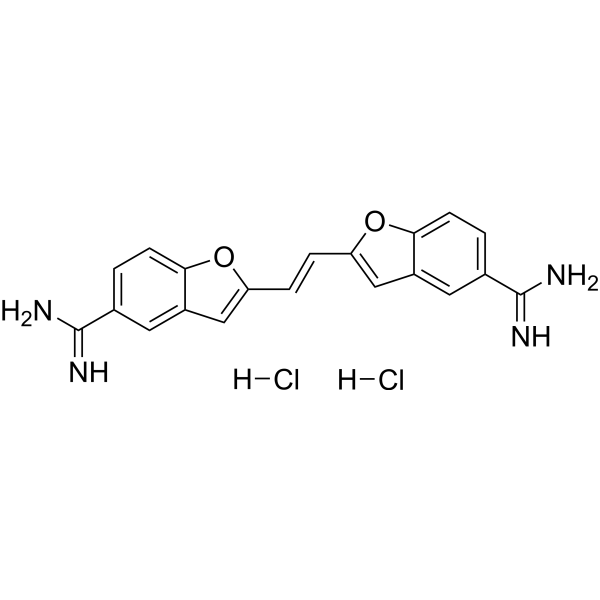
-
- HY-D0069
-
|
|
Fluorescent Dye
|
Others
|
|
CPM is a maleimide derivative, acting as a blue fluorescent thiol-reactive dye. The excitation/emission maxima is 384/470 nm .
|
-

-
- HY-117070
-
|
|
Fluorescent Dye
|
Others
|
|
TO-PRO-3 iodide is a highly efficient blue fluorescent dye that can stain cytoplasm as a cell tracer.
|
-

-
- HY-D1256
-
|
|
Fluorescent Dye
|
Neurological Disease
Metabolic Disease
|
|
Msr-blue is a first turn-on fluorescent probe for methionine sulfoxide reductase with a more than 100-fold fluorescence increment. Msr-blue is used for monitoring the enzyme activity in live cells (λex=340 nm, λem=440 nm) .
|
-

-
- HY-137845
-
|
|
Fluorescent Dye
|
Others
|
|
4-Methylumbelliferyl β-D-galactopyranoside is a fluorescent substrate for β-galactosidase which, when cleaved, produces a water-soluble blue fluorescent coumarin fluorophore that can be detected using a fluoroenzymeter or fluorometer .
|
-

-
- HY-124171
-
|
|
Fluorescent Dye
|
Others
|
|
Zinquin ethyl ester is a fluorescent derivative of Zinquin and is a fluorescent probe of cytosolic zinc. Zinquin ethyl ester is able to penetrate cell membranes and is lipophilic and zinc-sensitive. Zinquin ethyl ester can combine with Zn 2+ in the presence of Ca 2+ and Mg 2+ to produce blue fluorescence .
|
-
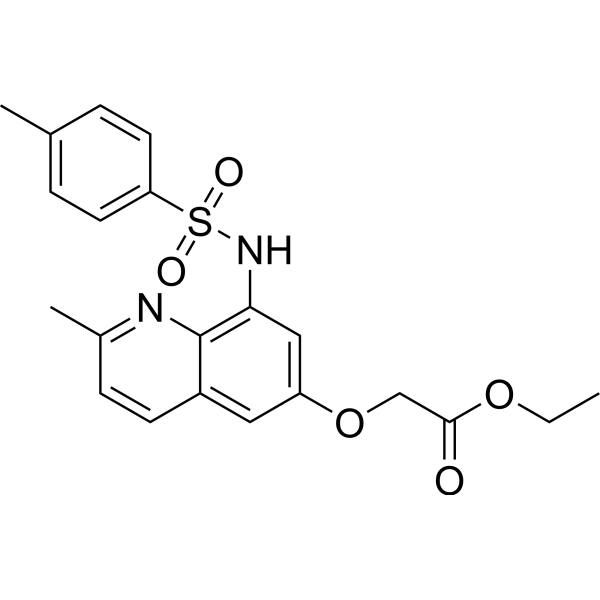
-
- HY-D0055
-
|
|
Cytochrome P450
|
Others
|
|
3-Cyano-7-ethoxycoumarin is a fluorogenic cytochrome P-450 substrate that generates blue fluorescent product upon enzyme cleavage
Target: Cytochrome P450
3-Cyano-7-ethoxycoumarin is a fluorescent probe useful in microsomal dealkylase studies.
|
-

-
- HY-118540
-
|
Diazoresorcinol
|
Fluorescent Dye
|
Others
|
|
Resazurin (Diazoresorcinol) is a water-soluble, non-toxic, stable, membrane-permeable blue non-fluorescent dye (faintly fluorescent). Resazurin is used as a redox indicator, can be reduced to pink, highly fluorescent Resorufin (Ex=530-560 nm, Em=590 nm) in living cells. Resazurin can be used for the detection of cell viability, toxicity, proliferation, migration and invasion in cells (human, plant and animal, bacterial and fungal) .
|
-

-
- HY-D1254
-
|
NBL-SS perchlorate
|
Fluorescent Dye
|
Others
|
|
Trx-red (NBL-SS perchlorate) is a red-emitting fluorescent probe derivatized from the nile blue fluorophore. Trx-red is used for selectively imaging thioredoxin (Trx) in live cells and in vivo (λex=615 nm, λem=661 nm) .
|
-
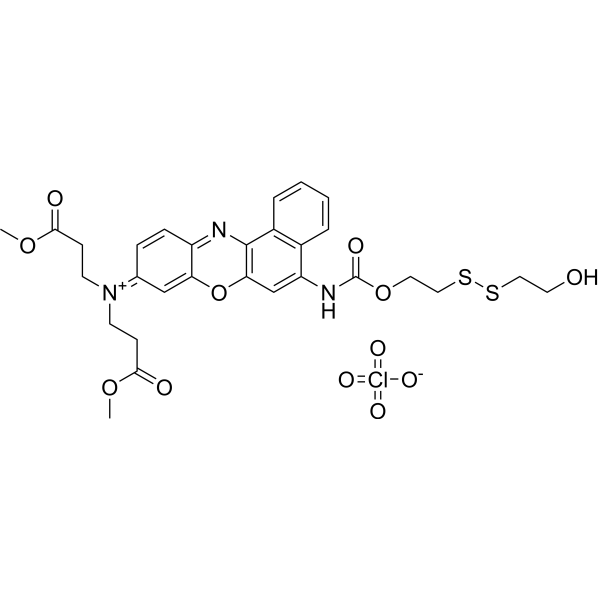
-
- HY-131045
-
|
HCC-Amino-D-alanine hydrochloride
|
Bacterial
|
Infection
|
|
HADA hydrochloride (HCC-Amino-D-alanine hydrochloride) is a blue (λem~450 nm) fluorescent D-amino acid (FDAA). FDAAs are efficiently incorporated into the peptidoglycans (PGs) of diverse bacterial species at the sites of PG biosynthesis, allowing specific and covalent probing of bacterial growth with minimal perturbation .
|
-
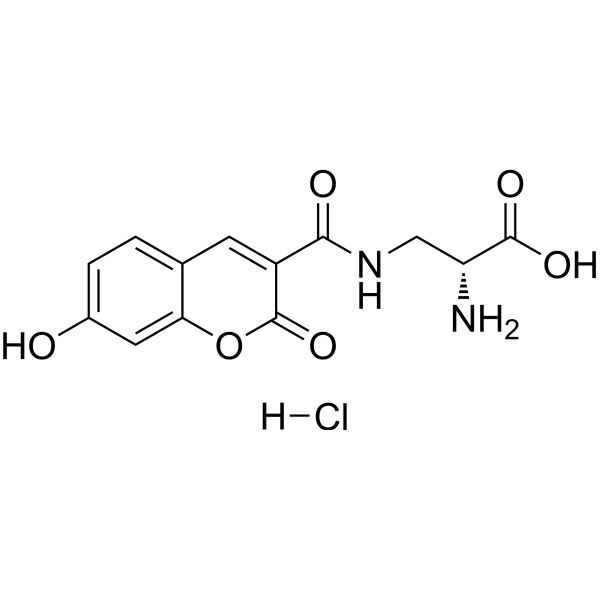
-
- HY-D0025
-
|
|
Fluorescent Dye
|
Others
|
|
7-Amino-4-methylcoumarin-3-acetic acid is a fluorescent protein labelling agent. 7-Amino-4-methylcoumarin-3-acetic acid emits in the blue region (440-460 nm) on activation with UV light (350 nm) .
|
-
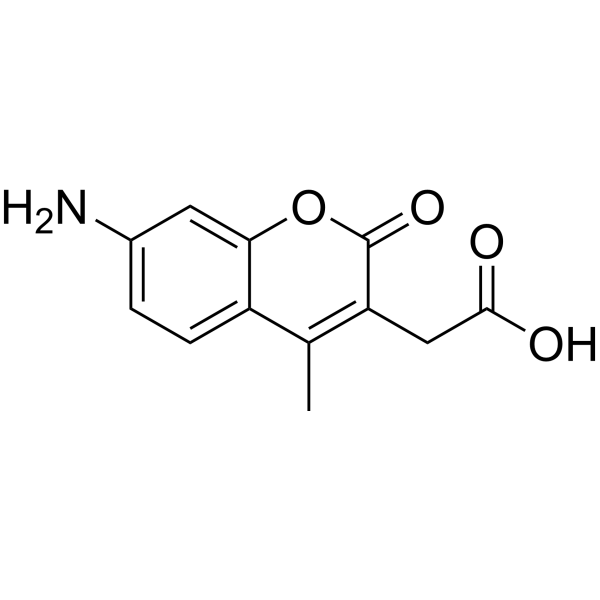
-
- HY-118135
-
|
4MU-α-Gal
|
Fluorescent Dye
|
Others
|
|
4-Methylumbelliferyl-α-D-galactopyranoside (4MU-α-Gal), a substrate for α-galactosidase A (GLA), is a blue pro-fluorogenic substrate. 4-Methylumbelliferyl-α-D-galactopyranoside forms two products, galactose and fluorescent 4MU, upon cleavage by GLA .
|
-
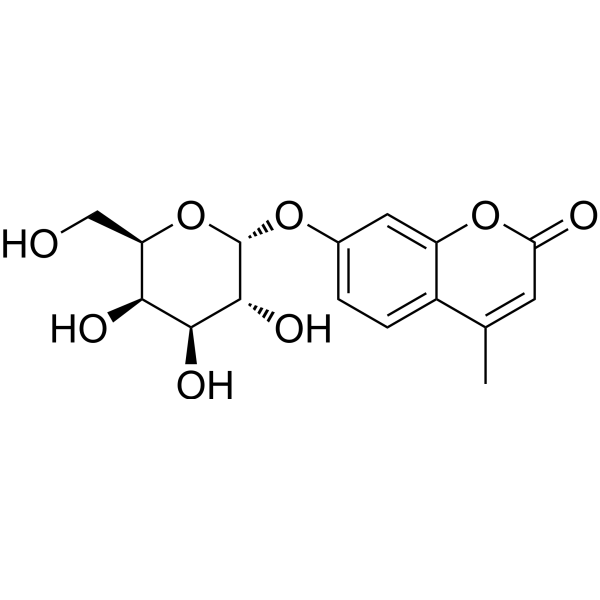
-
- HY-D0079
-
|
Hydroethidine; PD-MY 003
|
Fluorescent Dye
|
Others
|
|
Dihydroethidium, also known as DHE, is a peroxide indicator. Dihydroethidium penetrates cell membranes to form a fluorescent protein complex with blue fluoresces. After entering the cells, Dihydroethidium is mainly localized in the cell membrane, cytoplasm and nucleus, and the staining effect is the strongest in the nucleus. Dihydroethidium produces inherent blue fluorescence with a maximum excitation wavelength of 370 nm and a maximum emission wavelength of 420 nm; after dehydrogenation, Dihydroethidium combines with RNA or DNA to produce red fluorescence with a maximum excitation wavelength of 300 nm and a maximum emission wavelength of 610 nm. 535 nm can also be used as the excitation wavelength for actual observation .
|
-

-
- HY-D1738
-
|
4',6-Diamidino-2-phenylindole dilactate
|
Fluorescent Dye
|
|
|
DAPI (dilactate) is a blue fluorescent dye that preferentially binds dsDNA and binds to minor groove AT clusters. DAPI (dilactate) is combined with dsDNA, and the fluorescence was enhanced about 20-fold. DAPI (dilactate) can be used to identify the cell cycle and specifically stains the nucleus but not the cytoplasm. DAPI (dilactate) form is more soluble in water than DAPI (dihydrochloride) form.
|
-
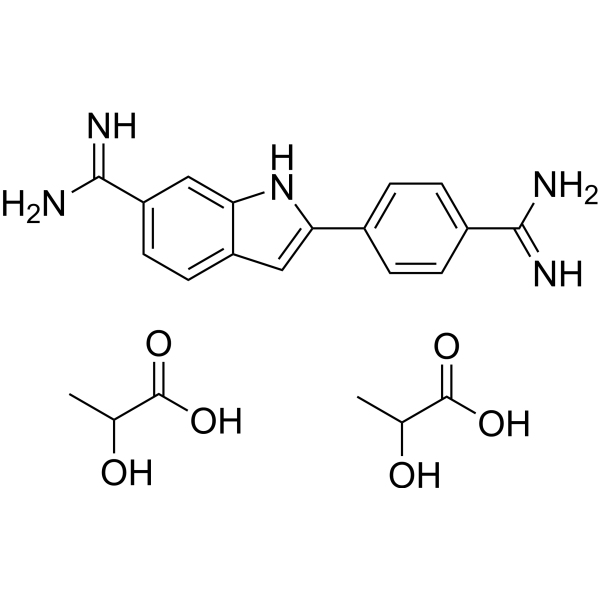
-
- HY-N7171
-
|
4,4'-DiOMEA; Nasutin C
|
Wnt
|
Cancer
|
|
4,4'-Di-O-methylellagic acid (4,4'-DiOMEA; Nasutin C) can be isolated from the Australian termites. 4,4'-Di-O-methylellagic acid is blue-fluorescent under ultra-violet light . 4,4'-Di-O-methylellagic acid inhibits colon cancer cell proliferation via the wnt signal pathway .
|
-
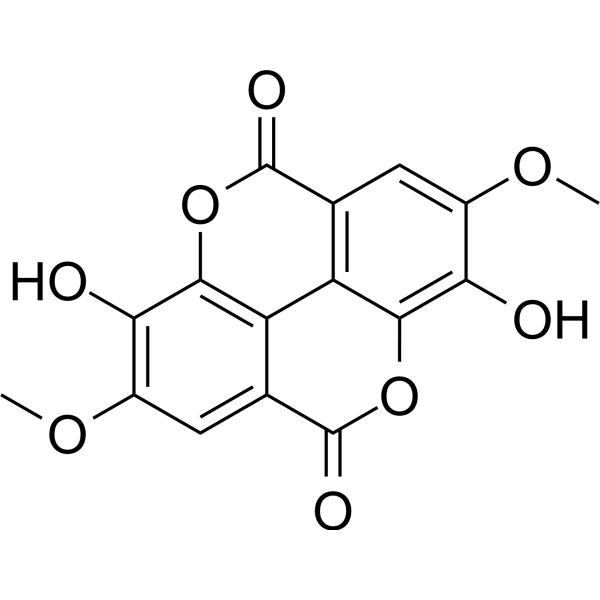
-
- HY-D0915
-
|
Acid blue 9; FD&C blue No. 1; E133
|
Fluorescent Dye
|
Others
|
|
Brilliant Blue FCF is an aromatic hydrocarbon, a synthetic dye produced from petroleum and used as a colorant for food and other substances. The solution has a maximum absorption at 628 nm.
|
-
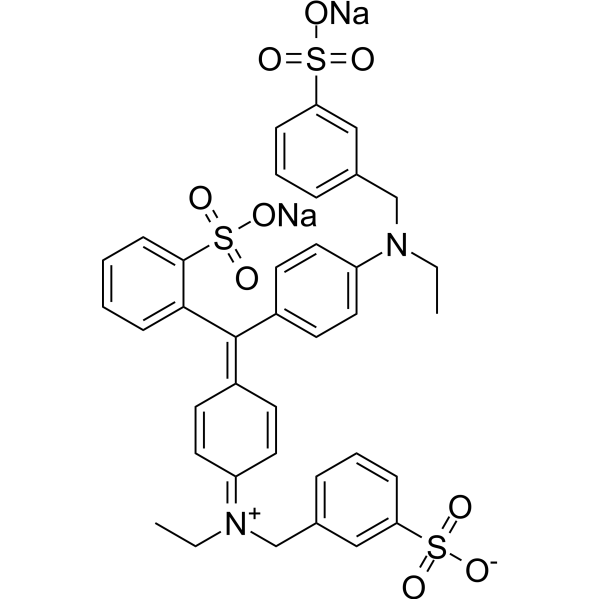
-
- HY-D0718
-
|
Nile blue A oxazone; Phenoxazone 9
|
Fluorescent Dye
|
Others
|
|
Nile red (Nile blue oxazone) is a lipophilic stain. Nile red has environment-sensitive fluorescence. Nile red is intensely fluorescent in a lipid-rich environment while it has minimal fluorescence in aqueous media. Nile red is an excellent vital stain for the detection of intracellular lipid droplets by fluorescence microscopy and flow cytof uorometry. Nile red stains intracellular lipid droplets red. The fluorescence wavelength is 559/635 nm .
|
-
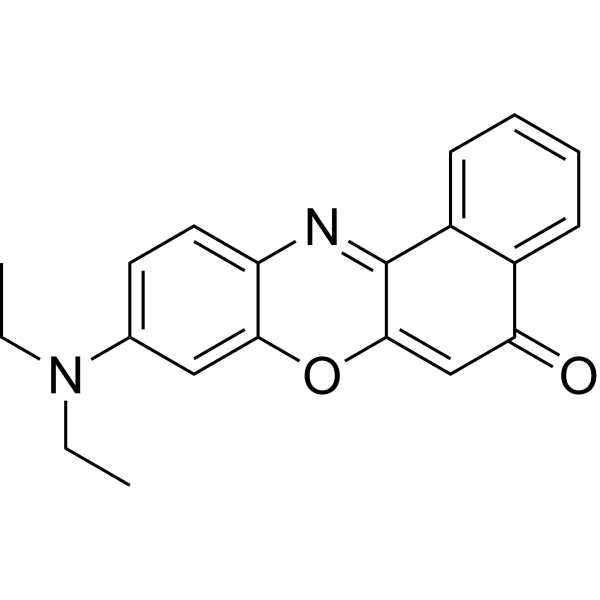
-
- HY-D0027
-
|
Coumarin 120; AMC
|
Fluorescent Dye
Antibiotic
Fungal
|
Infection
|
|
7-Amino-4-methylcoumarin belongs to a group of coumarins. 7-Amino-4-methylcoumarin can be isolated from an endophytic fungus Xylaria sp., has broad antimicrobial activity. 7-Amino-4-methylcoumarin is additionally commonly used as an important laser dye emitting in the blue region, as well as a fluorescent probe enabling analyses of glycoproteins’ monosaccharides and N-linked oligosaccharides. The excitation wavelength and emission wavelength are 351 nm and 430 nm, respectively .
|
-
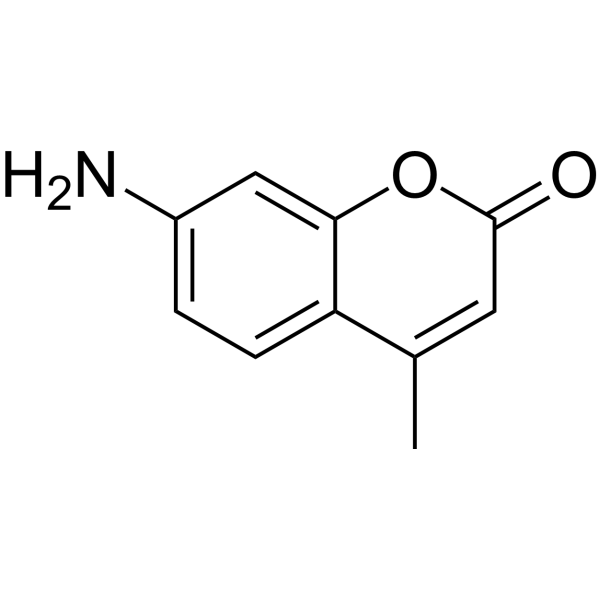
-
- HY-W250148
-
|
Spirit nigrosine
|
Biochemical Assay Reagents
|
Others
|
|
Solvent black 5 (Spirit nigrosine) is a synthetic dye belonging to the family of azo dyes. Also known as oil black or naphthol black, it is dark blue-black and has excellent solubility in organic solvents. Solvent black 5 is commonly used as a colorant in various industrial applications such as printing inks, coatings and plastics. It can also be used as an indicator dye to detect the presence of metals in solution. Furthermore, due to its high absorption and emission properties in the near-infrared region, it has been used in scientific research as a fluorescent biomarker for tissues and cells. However, Solvent black 5 has been reported to have potentially toxic effects on human health and the environment and its use is therefore regulated in some countries.
|
-
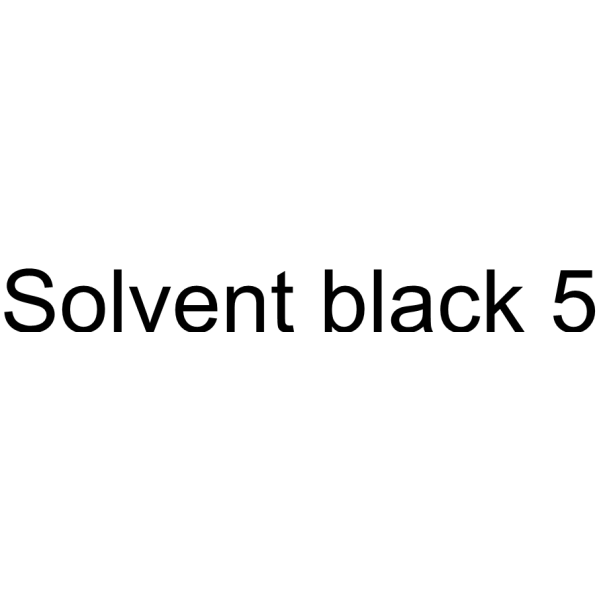
| Cat. No. |
Product Name |
Type |
-
- HY-D0068
-
|
7-Diethylaminocoumarin-3-carboxylic acid, SE
|
Fluorescent Dyes/Probes
|
|
DEAC, SE (7-Diethylaminocoumarin-3-carboxylic acid, SE) is an excellent blue fluorescent building block for labeling amine-containing biomolecules.
|
-
- HY-W011618
-
|
|
Fluorescent Dyes/Probes
|
|
N-(9-Acridinyl)maleimide is a maleimide type fluorescent thiol reagent. N-(9-Acridinyl)maleimide shows no substantial fluorescence but its coupling products with thiol compounds exhibit strong blue fluorescence. N-(9-Acridinyl)maleimide is used for fluorometrical analysis of cysteine and glutathione .
|
-
- HY-145385
-
|
|
Fluorescent Dyes/Probes
|
|
Coelenteramide is a oxidative product of Coelenterazine (HY-18743). Coelenteramide can form a complex with apoAequorin/Ca 2+, which is known as blue fluorescent protein (BFP) and shows continuous weak luminescence with Coelenterazine like a luciferase. Coelenteramide can be used as an imaging agent .
|
-
- HY-D0115
-
|
|
Fluorescent Dyes/Probes
|
|
7-Hydroxycoumarin-3-carboxylic acid N-succinimidyl ester is the amine-reactive succinimidyl ester of 7-Hydroxycoumarin-3-carboxylic acid. 7-Hydroxycoumarin-3-carboxylic acid N-succinimidyl ester is a blue fluorescent dye for labeling proteins and nucleic acids .
|
-
- HY-D1775
-
|
|
Fluorescent Dyes/Probes
|
|
Lysotracker blue DND-22 is a blue-fluorescent probe for staining acidic compartments in live cells.
|
-
- HY-D1445
-
|
|
Fluorescent Dyes/Probes
|
|
PDMPO, a lysosome pH indicator, is an excellent fluorescent acidotropic reagent for fluorescence imaging. PDMPO is a potent tool with which to study acidic organelles of live cells. PDMPO exhibits pH-dependent dual-excitation and dual-emission spectral peaks. PDMPO produces a blue fluorescence in weakly acidic organelles and shifts to yellow in more acidic lysosomes (Abs=329 nm; Em=440 nm) .
|
-
- HY-101887
-
|
|
Fluorescent Dyes/Probes
|
|
Calcein Blue, a membrane-impermeant fluorescent dye, is a coumarin derivative that contains an iminodiacetic acid structure. Calcein Blue is also a metallofluorochromic indicator .
|
-
- HY-D0017
-
|
DNSCl
|
Protein Labeling
|
|
Dansyl chloride is a reagent that produces stable blue or blue-green fluorescent sulfonamide adducts in the reaction of aliphatic and aromatic amines with primary amino groups, and is widely used for modified amino acids, protein sequencing and amino acid analysis .
|
-
- HY-D1161
-
|
NCI 240899
|
Fluorescent Dyes/Probes
|
|
True Blue (NCI 240899) is a fluorescent dye, as neuronal retrograde tracer (excitation wavelength 395-425 nm, barrier filter 450 nm). True Blue can label neuron and has no effects on neuronal survival .
|
-
- HY-D0069
-
|
|
Fluorescent Dyes/Probes
|
|
CPM is a maleimide derivative, acting as a blue fluorescent thiol-reactive dye. The excitation/emission maxima is 384/470 nm .
|
-
- HY-117070
-
|
|
Fluorescent Dyes/Probes
|
|
TO-PRO-3 iodide is a highly efficient blue fluorescent dye that can stain cytoplasm as a cell tracer.
|
-
- HY-D1256
-
|
|
Fluorescent Dyes/Probes
|
|
Msr-blue is a first turn-on fluorescent probe for methionine sulfoxide reductase with a more than 100-fold fluorescence increment. Msr-blue is used for monitoring the enzyme activity in live cells (λex=340 nm, λem=440 nm) .
|
-
- HY-137845
-
|
|
Fluorescent Dyes/Probes
|
|
4-Methylumbelliferyl β-D-galactopyranoside is a fluorescent substrate for β-galactosidase which, when cleaved, produces a water-soluble blue fluorescent coumarin fluorophore that can be detected using a fluoroenzymeter or fluorometer .
|
-
- HY-124171
-
|
|
Fluorescent Dyes/Probes
|
|
Zinquin ethyl ester is a fluorescent derivative of Zinquin and is a fluorescent probe of cytosolic zinc. Zinquin ethyl ester is able to penetrate cell membranes and is lipophilic and zinc-sensitive. Zinquin ethyl ester can combine with Zn 2+ in the presence of Ca 2+ and Mg 2+ to produce blue fluorescence .
|
-
- HY-D0055
-
|
|
Chromogenic Substrates
|
|
3-Cyano-7-ethoxycoumarin is a fluorogenic cytochrome P-450 substrate that generates blue fluorescent product upon enzyme cleavage
Target: Cytochrome P450
3-Cyano-7-ethoxycoumarin is a fluorescent probe useful in microsomal dealkylase studies.
|
-
- HY-118540
-
|
Diazoresorcinol
|
Fluorescent Dyes/Probes
|
|
Resazurin (Diazoresorcinol) is a water-soluble, non-toxic, stable, membrane-permeable blue non-fluorescent dye (faintly fluorescent). Resazurin is used as a redox indicator, can be reduced to pink, highly fluorescent Resorufin (Ex=530-560 nm, Em=590 nm) in living cells. Resazurin can be used for the detection of cell viability, toxicity, proliferation, migration and invasion in cells (human, plant and animal, bacterial and fungal) .
|
-
- HY-D1254
-
|
NBL-SS perchlorate
|
Fluorescent Dyes/Probes
|
|
Trx-red (NBL-SS perchlorate) is a red-emitting fluorescent probe derivatized from the nile blue fluorophore. Trx-red is used for selectively imaging thioredoxin (Trx) in live cells and in vivo (λex=615 nm, λem=661 nm) .
|
-
- HY-131045
-
|
HCC-Amino-D-alanine hydrochloride
|
Dyes
|
|
HADA hydrochloride (HCC-Amino-D-alanine hydrochloride) is a blue (λem~450 nm) fluorescent D-amino acid (FDAA). FDAAs are efficiently incorporated into the peptidoglycans (PGs) of diverse bacterial species at the sites of PG biosynthesis, allowing specific and covalent probing of bacterial growth with minimal perturbation .
|
-
- HY-D0025
-
|
|
Fluorescent Dyes/Probes
|
|
7-Amino-4-methylcoumarin-3-acetic acid is a fluorescent protein labelling agent. 7-Amino-4-methylcoumarin-3-acetic acid emits in the blue region (440-460 nm) on activation with UV light (350 nm) .
|
-
- HY-D0079
-
|
Hydroethidine; PD-MY 003
|
Fluorescent Dyes/Probes
|
|
Dihydroethidium, also known as DHE, is a peroxide indicator. Dihydroethidium penetrates cell membranes to form a fluorescent protein complex with blue fluoresces. After entering the cells, Dihydroethidium is mainly localized in the cell membrane, cytoplasm and nucleus, and the staining effect is the strongest in the nucleus. Dihydroethidium produces inherent blue fluorescence with a maximum excitation wavelength of 370 nm and a maximum emission wavelength of 420 nm; after dehydrogenation, Dihydroethidium combines with RNA or DNA to produce red fluorescence with a maximum excitation wavelength of 300 nm and a maximum emission wavelength of 610 nm. 535 nm can also be used as the excitation wavelength for actual observation .
|
-
- HY-D1738
-
|
4',6-Diamidino-2-phenylindole dilactate
|
Fluorescent Dyes/Probes
|
|
DAPI (dilactate) is a blue fluorescent dye that preferentially binds dsDNA and binds to minor groove AT clusters. DAPI (dilactate) is combined with dsDNA, and the fluorescence was enhanced about 20-fold. DAPI (dilactate) can be used to identify the cell cycle and specifically stains the nucleus but not the cytoplasm. DAPI (dilactate) form is more soluble in water than DAPI (dihydrochloride) form.
|
-
- HY-D0915
-
|
Acid blue 9; FD&C blue No. 1; E133
|
Dyes
|
|
Brilliant Blue FCF is an aromatic hydrocarbon, a synthetic dye produced from petroleum and used as a colorant for food and other substances. The solution has a maximum absorption at 628 nm.
|
-
- HY-D0718
-
|
Nile blue A oxazone; Phenoxazone 9
|
Fluorescent Dyes/Probes
|
|
Nile red (Nile blue oxazone) is a lipophilic stain. Nile red has environment-sensitive fluorescence. Nile red is intensely fluorescent in a lipid-rich environment while it has minimal fluorescence in aqueous media. Nile red is an excellent vital stain for the detection of intracellular lipid droplets by fluorescence microscopy and flow cytof uorometry. Nile red stains intracellular lipid droplets red. The fluorescence wavelength is 559/635 nm .
|
-
- HY-D0027
-
|
Coumarin 120; AMC
|
Fluorescent Dyes/Probes
|
|
7-Amino-4-methylcoumarin belongs to a group of coumarins. 7-Amino-4-methylcoumarin can be isolated from an endophytic fungus Xylaria sp., has broad antimicrobial activity. 7-Amino-4-methylcoumarin is additionally commonly used as an important laser dye emitting in the blue region, as well as a fluorescent probe enabling analyses of glycoproteins’ monosaccharides and N-linked oligosaccharides. The excitation wavelength and emission wavelength are 351 nm and 430 nm, respectively .
|
-
- HY-W250148
-
|
Spirit nigrosine
|
Dyes
|
|
Solvent black 5 (Spirit nigrosine) is a synthetic dye belonging to the family of azo dyes. Also known as oil black or naphthol black, it is dark blue-black and has excellent solubility in organic solvents. Solvent black 5 is commonly used as a colorant in various industrial applications such as printing inks, coatings and plastics. It can also be used as an indicator dye to detect the presence of metals in solution. Furthermore, due to its high absorption and emission properties in the near-infrared region, it has been used in scientific research as a fluorescent biomarker for tissues and cells. However, Solvent black 5 has been reported to have potentially toxic effects on human health and the environment and its use is therefore regulated in some countries.
|
-
- HY-K0901
-
|
|
|
AMCA Phalloidin is Phalloidin conjugated to the fluorescent dye AMCA. Phalloidin binds F-actins with high selectivity while AMCA provides stable and bright blue fluorescence.
|
| Cat. No. |
Product Name |
Category |
Target |
Chemical Structure |
Your information is safe with us. * Required Fields.
Inquiry Information
- Product Name:
- Cat. No.:
- Quantity:
- MCE Japan Authorized Agent:





































